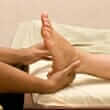Background
- Reflexology involves the application of manual pressure to specific points or areas of the feet called "reflex points" that are believed to correspond to other parts of the body. Reflexology is often used with the intention to relieve stress or prevent/treat physical disorders. Pressure may also be applied to the hands or ears.
- Techniques similar to reflexology have existed for thousands of years, and were used by ancient Egyptians and early Chinese. In the early 20th Century, an American ear, nose, and throat physician, William Fitzgerald, MD, suggested that the foot could be "mapped" to other areas of the body in order to diagnose and treat medical conditions. He divided the body into 10 zones and labeled sections of the foot he believed to control each zone. Dr. Fitzgerald suggested that gentle pressure on a particular area of the foot could generate relief in the targeted zone. This process was originally named zone therapy.
- In the 1930s, Eunice Ingham, a nurse and physiotherapist, further developed these maps to include specific reflex points. At this time, the name zone therapy was changed to reflexology. Modern reflexologists in the United States often learn Ingham's method or a similar technique developed by the reflexologist Laura Norman.
- Reflexology charts consist of pictures of the soles of the feet on which diagrams of corresponding internal organs or parts of the body are drawn. For example, charts may display that the toes correspond to the head and neck, the ball of the foot to the chest and lungs, the arch of the foot to the internal organs, the heel to the sciatic nerve and pelvic area, and the bone along the arch of the foot to the spine. The right side of the body is believed to be reflected in the right foot, and the left side in the left foot.
- Although most reflexologists formally claim that these relationships are not used to diagnose disease, practicing reflexologists sometimes assert that tenderness or a gritty feeling of the feet represents current or past disease in the corresponding area of the body.
- Reflexology is sometimes combined with other techniques, and may be used by healthcare practitioners of various disciplines (such as massage therapists, chiropractors, podiatrists, physical therapists, or nurses).
- Reflexology is primarily based on Western physiological concepts of reflexes and the nervous system, rather than Oriental concepts of energy meridians or acupuncture points. Thus reflexology was not introduced as a form of energy medicine per se, but rather as a form of massage therapy and bodywork based on Western anatomical principles.
- Reflexology is sometimes confused with acupressure (shiatsu), which is based solely on Oriental energetic principles. While the two modalities are based on different theories of mechanisms of action, some modern reflexologists now incorporate some Oriental energetic principles in their understanding of the possible mechanisms of reflexology.
- Practitioners range from those who taught themselves from books to individuals who attended training courses and belong to professional associations. Techniques can be learned and self-administered. No widely accepted regulatory systems exist for reflexology, and there is currently no state licensure or training requirement in the United States.
References
- Bamigboye AA, Smyth R. Interventions for varicose veins and leg oedema in pregnancy. Cochrane Database Syst Rev 2007 Jan 24;(1):CD001066.
View Abstract - Bennedbaek O, Viktor J, Carlsen KS, et al. [Infants with colic. A heterogeneous group possible to cure? Treatment by pediatric consultation followed by a study of the effect of zone therapy on incurable colic]. Ugeskr Laeger 2001;163(27):3773-3778.
- Bosiger C. Vacuflex reflexology study shows the system is successful in clearing back pain. J Altern Comp Med 1989;7(8):25-26.
- Botting D. Review of the literature on the effectiveness of reflexology. Complement Ther Nurs Midwifery 1997;3(5):123-130.
- Brygge T, Heinig JH, Collins P, et al. Reflexology and bronchial asthma. Respir Med 2001;95(3):173-179.
- Carpenter JS, Neal JG. Other complementary and alternative medicine modalities: acupuncture, magnets, reflexology, and homeopathy. Am J Med 2005 Dec 19;118 Suppl 12B:109-17.
View Abstract - Ernst E, Koder K. An overview of reflexology. Eur J Gen Practice 1997; 3:52-57.
- Gunnarsdottir TJ, Jonsdottir H. Does the experimental design capture the effects of complementary therapy? A study using reflexology for patients undergoing coronary artery bypass graft surgery. J Clin Nurs 2007 Apr;16(4):777-85.
View Abstract - Hayes J, Cox C. Immediate effects of a five-minute foot massage on patients in critical care. Intensive Crit Care Nurs 1999;15(2):77-82.
- Hodgson H. Does reflexology impact on cancer patients' quality of life? Nurs Stand 2000;14(31):33-38.
- Kohara H, Miyauchi T, Suehiro Y, et al. Combined modality treatment of aromatherapy, footsoak, and reflexology relieves fatigue in patients with cancer. J Palliat Med 2004 Dec;7(6):791-6.
View Abstract - Launso L, Brendstrup E, Arnberg S. An exploratory study of reflexological treatment for headache. Altern Ther Health Med 1999;5(3):57-65.
- Oleson T, Flocco W. Randomized controlled study of premenstrual symptoms treated with ear, hand, and foot reflexology. Obstet Gynecol 1993;82(6):906-911.
- Siev-Ner I, Gamus D, Lerner-Geva L, et al. Reflexology treatment relieves symptoms of multiple sclerosis: a randomised controlled study (abstract). 4th Annual Symposium on Complementary Healthcare, Exeter England, December 10-12, 1997 (reprinted in: Focus Altern Complement Ther 1997;2:196).
- Stephenson NL, Weinrich SP, Tavakoli AS. The effects of foot reflexology on anxiety and pain in patients with breast and lung cancer. Oncol Nurs Forum 2000;27(1):67-72.







